Homeowner's Guide to Geologic Hazards

"How did this happen?" and "Where can I get help?" are usually the first questions asked by a homeowner threatened by landslides, flooding, subsidence, or groundwater problems.
This guide can help answer those questions.
Introduction
Do geologic hazards threaten your home or building site? Will it flood? Is it undermined? Is it settling or sliding? Does the well go dry? Are there cracks in walls or floors? Unfortunately, many homeowners and homebuyers often fail to recognize these problems, and do not ask the right questions before buying a house or land.
Within the limits of corporate areas, the homebuyer is assumed to be protected from known hazards by city zoning and building codes, building permits, city inspections, public water and sewer service, and fire protection. But, as more homes are built in rural areas and unincorporated developments, homebuyers soon discover that urban protection is not included with a country purchase.
This article discusses geologic hazards common to West Virginia homesites, presents a checklist for recognizing these hazards, and provides sources of assistance.
The Setting
The ideal setting for a home is on nearly-level land, high enough to be above flooding, with stable soil or rock for foundations, an adequate water supply, a safe septic waste disposal system, and a convenient access road from a public highway. But homesites in West Virginia are rarely ideal. They are along streams, on terraces, on steep hillsides, up the hollows, and on ridges. Each of these settings has problems with particular geologic conditions. For example:
- Land along streams is subject to flooding.
- Landslides occur along steep hillsides.
- Terraces have soft, sticky soil and seasonal, high ground-water levels.
- Ridge tops are drought-prone and may require deep water wells.
Geologic Hazards
A geologic hazard is any landscape feature or geologic condition that endangers the house or causes critical problems for its owner. The most common hazards in West Virginia are floods, landslides, subsidence, and ground water. Each of these hazards is discussed below.
Floods--which occur periodically when high-water flow overtops the stream-channel banks and inundates the floodplain and houses on it (Figure 1). Some houses are washed away, others are smashed by floating debris, while those remaining are filled with contaminated mud when floodwaters recede. Floods are classed by their magnitude and frequency of occurrence, such as the "50-year" or "100-year" flood. This means that a flood of certain magnitude will statistically occur once in 50 or 100 years (although it may occur more or less often). For homes located below the 100-year flood elevation, flood insurance is available in West Virginia, and building permits are required for new homes.
Figure 1. Destroyed houses in Petersburg, Grant County, are casualties of the November 1985 flood.
(Photo by Peter Lessing)
Landslides--mass movements of soil and/or rock down a slope, due to gravity and usually water. Slips, slumps, rock falls, slides, flows, and creep are terms used by geologists to identify specific mechanisms and velocities for mass movement (Figure 2). Most slopes in West Virginia are vulnerable, especially after heavy rain or snow melt; the telltale signs are hummocky surfaces, leaning and bent trees or utility poles, many seeps and sag ponds (water-filled depressions), and old or recent landslides where horizontal and vertical movement has occurred.
Figure 2. A typical landslide. Slump scarp is at the head, and earthflow is at the toe.
(Illustration by Paul Queen)
Slides are both natural and man-made. Man-made slope failures are generally caused by overloading the head (top) of an old slide with fill, excavating the toe (bottom) of an old slide, recharging the zones of ground-water movement beyond their capacities in a slide-prone area, or a combination of these (Figure 3). Slow creep movement gradually opens cracks in house walls, floors, and pavements, and causes support posts and pillars to lean (Figure 4). Rapid slide or flow movement usually happens without warning, breaking apart house walls, tilting floors, and pulling apart buried water, gas, and sewer lines (Figure 5). Houses are often pushed from their foundations, and are sometimes even buried.
Figure 3. Slump and earthflow in a new housing development.
(Photo by Peter Lessing)
Figure 4. Cracked and dislocated street across an old slide resulted from soil movement under weight. House is now endangered.
(Photo by USDA-Natural Resources Conservation Service)
Figure 5. July 1973 landslide in Kanawha City, Kanawha County.
(Photo courtesy of the Charleston Gazette)
Subsidence--the differential settlement of land that causes house walls to crack, doors and windows to bind, floors and pavements to break open and drop, and if the vertical movement is sufficient, the entire house to tilt (Figures 6 and 7). Subsidence may be accompanied by frost heaving, shrink-swell of clay materials, and sometimes landslides. Three types of subsidence common to West Virginia are related to mines, karst topography, and fills and are discussed below.
Figure 6.Cracked basement masonry that will not allow door to close.
(Photo by Peter Lessing)
Figure 7. Subsidence damage. Tension cracks and differential settlement of walls and doors is typical (note door on right).
(Photo by Ray Strawser)
Mine subsidence occurs when the land over underground mines settles after the mine roof falls in (Figure 8). In 40 of the West Virginia counties where coal has been mined, mine subsidence insurance is part of every homeowner's insurance policy unless it is waived by the policy holder. In Berkeley, Cabell, Calhoun, Hampshire, Hardy, Jackson, Jefferson, Monroe, Morgan, Pendleton, Pleasants, Ritchie, Roane, Wirt, and Wood Counties, no waiver is required and mine subsidence insurance is provided only if requested by the insured.
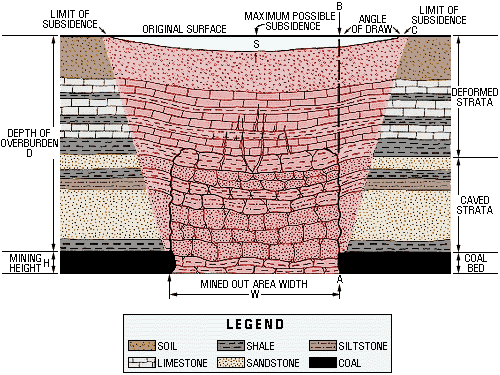
Figure 8. Generalized cross section of subsidence. The area on the surface affected by subsidence is usually wider than the area mined out below. The angle of draw is formed by a line from the edge of the mined area straight up to the surface (A-B), and a line from the edge of the mined area to the edge of the surface subsidence (A-C). The angle of draw does not exceed 45 degrees. In the northern Appalachian Basin, maximum possible subsidence (S) seldom exceeds 65% of the mining height (H). (For example, if 100 inches of coal were mined, the maximum surface subsidence would be 65 inches.) In general, for any given mined out area width (W), greater depth of overburden (D) results in less subsidence than the maximum possible subsidence (S). However, even small movements can damage a structure. (Adapted from S. Tandanand and L. R. Powell, 1982, Assessment of Subsidence Data from the Northern Appalachian Basin for Subsidence Prediction: U. S. Bureau of Mines Report of Investigations 8630. (Illustration by Ray Strawser)
In limestone areas, Karst subsidence occasionally occurs when land over caves and caverns or around sink holes settles and falls into the underground voids.
Fills are man-placed deposits of soil, rock, soil-rock mixtures, and industrial and municipal solid wastes. These materials are either dumped loosely at convenient disposal areas, or placed in strict accordance with stability specifications for future use (such as shopping center, airport, highway, or housing development). Fills usually occur as leveled deposits of surface mine spoil, highway construction wastes, head-of-hollow fills, "gob piles" or "slate dumps," slag heaps, and even buried garbage dumps and sanitary landfills. They are found in swamps, on floodplains and hillsides, up-the-hollows, and in the head-of-hollows after hilltop excavations. Until the nature of their variable contents, placement methods, stability characteristics, and foundation conditions are analyzed, the stability of fills for rigid-construction housing is questionable. Mobile homes are often located on fill sites because these homes can be leveled when settlement occurs.
Ground water--the water existing in rock strata below the ground surface. It occurs in (1) perched or shallow seasonal zones, saturated only during wet seasons; and in (2) deep zones of perennial saturation below the water table (Figure 9). Pervious soil, rock, or fracture zones through which water moves are aquifers. Perched aquifers usually supply the water to seeps encountered in foundations, basements, or road excavations. Unless drained, perched water can lead to wet or damp basements, mildew, loss of stable space, foundation slides or road slips, and malfunctions of septic leach fields (Figures 10a and 10b). Wells penetrating deep, fresh-water aquifers are used for water supplies. Such deep sources of water usually occur beneath the elevation of perennial springs or streams. In central and western West Virginia, brackish or salty water may exist beneath the fresh-water aquifers.
Normally, each household should have about 100 gallons of water per day per person for an adequate supply. Homeowners or buyers may have serious problems if their well goes dry, or encounters foul waters.
Since 1984, all wells to be drilled in West Virginia are required to have a drilling permit from the appropriate county health department. In addition, the well must be drilled by a certified well driller.
Figure 9. Perched water zones are seasonal and usually dry up during summer and fall. Fresh-water table depths vary from season to season, but the deeper sandstones usually provide adequate, all-year water supplies. Well A is too shallow: zone 1 is a seasonal perched water table and zone 2 is within the zone of the fluctuating water table. Well B, near the creek, found an adequate fresh-water supply in zone 3, but encountered brackish or salty water when drilled deeper into zone 4. (Illustration by Dan Barker
Figure 10a. Typical ground-water damage to basements without adequate foundation drainage.
(Illustration by Dan Barker)
Figure 10b. Foundation drainage system normally used for protection against ground-water damage.
(Illustration by Dan Barker)
Further Reading

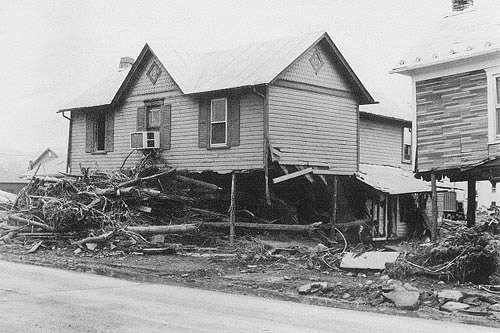
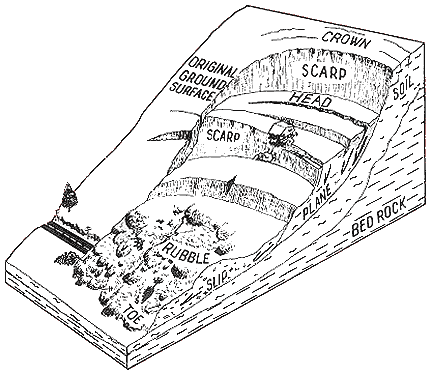
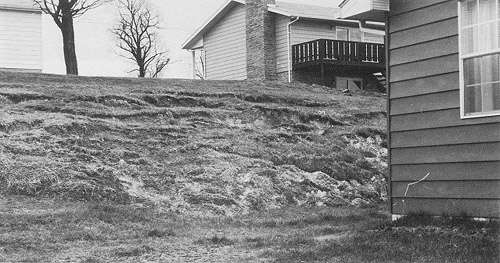
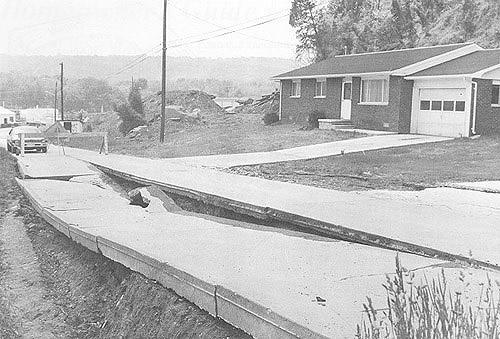
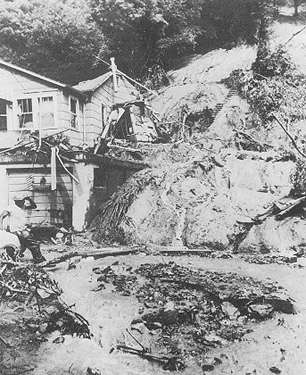
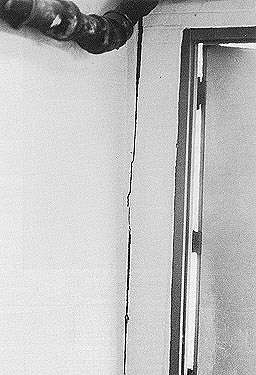
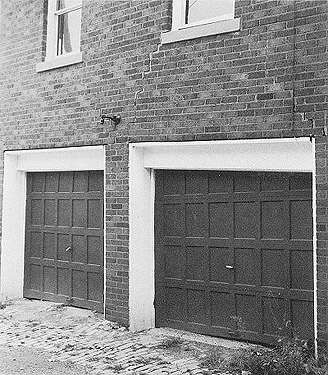

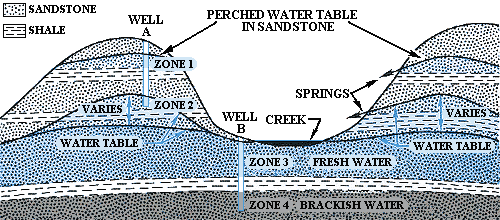
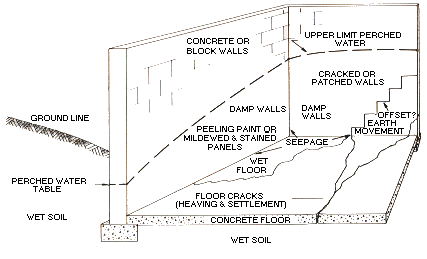
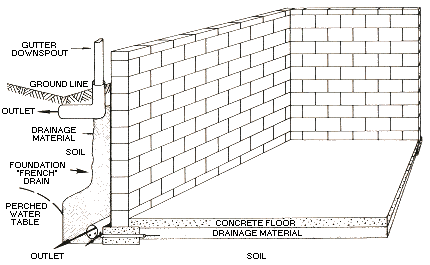
 (Original article by R. F. Fonner, Mountain State Geology, 1987; reviewed and updated by J. Steven Kite, Susan C. Kite, and Mary C. Behling in 1999.)
(Original article by R. F. Fonner, Mountain State Geology, 1987; reviewed and updated by J. Steven Kite, Susan C. Kite, and Mary C. Behling in 1999.)

 WV Geological & Economic Survey
WV Geological & Economic Survey